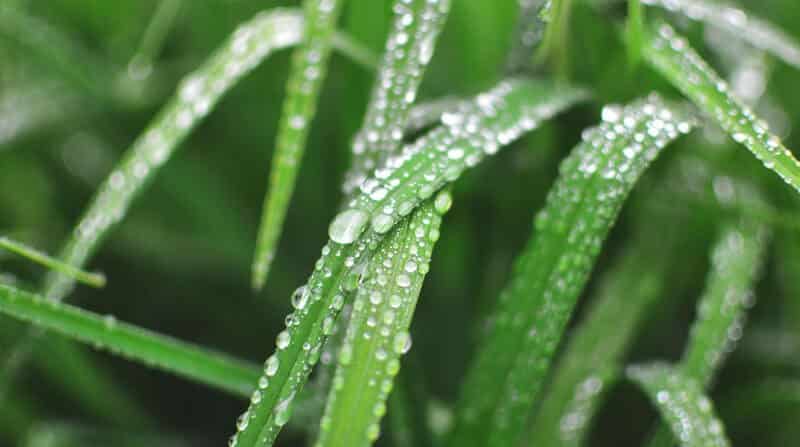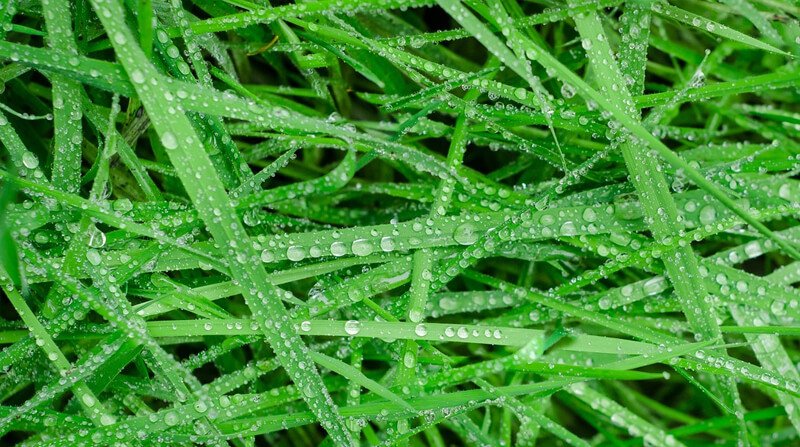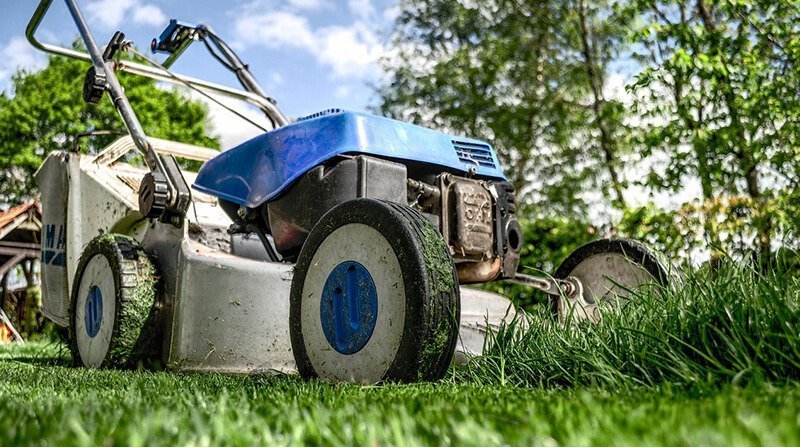The British climate is often a wet one. As such, it can be difficult to find a dry day to mow the lawn.
This can be especially tricky during spring and autumn when the grass is growing quickly, meaning you can’t mow as often as you’d like.
So this begs the question, ‘Can you cut wet grass?’
In this article, I’ll the reasons why cutting wet grass is a bad idea.
That said, I’m also aware that sometimes, needs must. So I’ll also show you how to mow wet grass as safely as possible and in a way that’s best for your lawn.
4 Big Reasons Why Mowing Wet Grass is a Bad Idea

There are several reasons why mowing wet grass is a bad idea.
It’s not only heavy rain that causes a problem either. Light rain and even morning dew create less than perfect mowing conditions.
Here are 4 reasons why you should avoid cutting wet grass.
It’s Unsafe
Using a piece of machinery with a spinning blade in the wet is never a good idea.
Firstly, if you use an electric lawnmower then the safety concerns are obvious – water and electricity aren’t the best of friends. People have died as a result of being electrocuted while cutting the grass when wet.
And it’s not just electric mowers which are dangerous. Even the best mower is a dangerous one when the ground is wet. Especially heavy mowers like petrol models and cylinder machines.
Another safety concern is the lawn becoming slippy.
On a flat lawn, this shouldn’t be an issue unless you’re already not great on your feet.
However, a sloped lawn could cause you to slip. A falling person in charge of spinning blades will rarely end well!
It’s Hard On Your Mower
A lot of moisture often means your lawn mower has to work harder, especially if the grass is long. This puts extra strain on the power source and in the case of cordless/rechargeable mowers, it can drain battery power much quicker than it would if the grass was dry.
It also puts more stress on the motor which drives the mower blade, especially if you have a mulching mower to mulch your clippings. This can reduce the lifespan of your mower.
Moisture also causes any metal parts to corrode and if it gets into the fuel tank of your petrol mower, it can affect the engine performance.
It’s Not Good For Your Lawn
For a perfect cut, the grass should be standing upright when you mow.
Wet grass is weighed down by moisture droplets. This causes it to lean over, long grass can often lie flat.
Of course, your mower will cut some of the grass. However, it’ll roll right over much of it, despite your mower being set at a low height.
The result is a very uneven, untidy cut. This is bad enough but wet grass doesn’t cut cleanly, it tends to tear.
It also causes the grass clippings to clump together, often being left on the lawn. This prevents light and air from being able to dry the grass.
Injuring the grass like this opens the door for fungal infections like lawn rust to creep in and infect your lawn.
Finally, the simple act of walking up and down with your mower can damage your lawn. The wheels digging into the surface can cause ruts in a way that they don’t when the ground is dry.
This not only produces a less than desirable finish but it can also damage the grass.
It Causes More Work
Cutting the grass when it’s wet takes more time. You need to do it slowly to get anywhere near a decent cut. Even then it won’t look very good so you’ll want to mow all over again as soon as the grass is dry.
You’ll also need to collect the clumps of wet grass clippings from your lawn as well as clean them off your mower which you can only really do with a garden hose.
If You Must Cut the Grass When it’s Wet, Here’s How to Do it

As you now know, I’m all against cutting wet grass.
It’s not good for your grass and on the whole, it’s a massive headache. So mow the lawn when it’s dry.
However, sometimes needs must and if you really must cut the lawn when it’s wet, here are a few tips;
- Mow in the Afternoon (if possible) – the afternoon is one of the best times of day to mow the lawn anyway. This gives your lawn as much chance of drying out as possible.
- Drag a hosepipe across the lawn – This will knock excess water off the grass. If you can wait for a little while longer, the grass will dry much quicker.
- Rake or brush the lawn – This will encourage the grass to stand up straight prior to mowing to give you the best chances of an even cut.
- Raise the height of your mower – Don’t mow wet grass too short. Taking the top off the grass instead of cutting it where it is most dense will rake load and stress off the blade and motor. So mow high.
- Sharpen the mower blade – Cutting wet grass with a dull blade will almost guarantee in it being torn out of the ground instead of being cut cleanly. So only mow wet grass with a sharp blade. If it’s blunt, sharpen it.
- Mow slowly – The motor and blade will have to work much harder than normal to cut through wet grass. Push your mower at least 50% slower than you normally would to give it a chance to get through the glass cleanly.
- Cut half rows – When you’ve cut your first row, position your lawnmower so that the next row is half-cut and half non-cut grass. This will reduce the load on the motor and blade and help cut the grass more effectively.
- Two passes – You might find that your lawn still has some bits of long grass because your lawnmower didn’t get through them the first time. As a result, you might need to give your lawn another pass (in a different direction).
- Clear any clumps of grass – When left on the lawn, these not only look ugly but they can encourage the onset of fungal disease.
- Clean your lawn mower – As soon as you’ve finished mowing the lawn, clean your lawnmower. Washing the grass off while it’s wet is much easier than scraping it off when it’s dry and hard.
In Conclusion
Can you cut wet grass?
Technically, yes, you can. However, if you can avoid it you should.
It’s bad for both your lawn and your mower, it takes more work and it can be dangerous.
If you can, wait until it’s dry and you’ll have much better results.
However, if you must do it, follow the tips I’ve provided and you should get a decent (I use that word loosely) cut.

